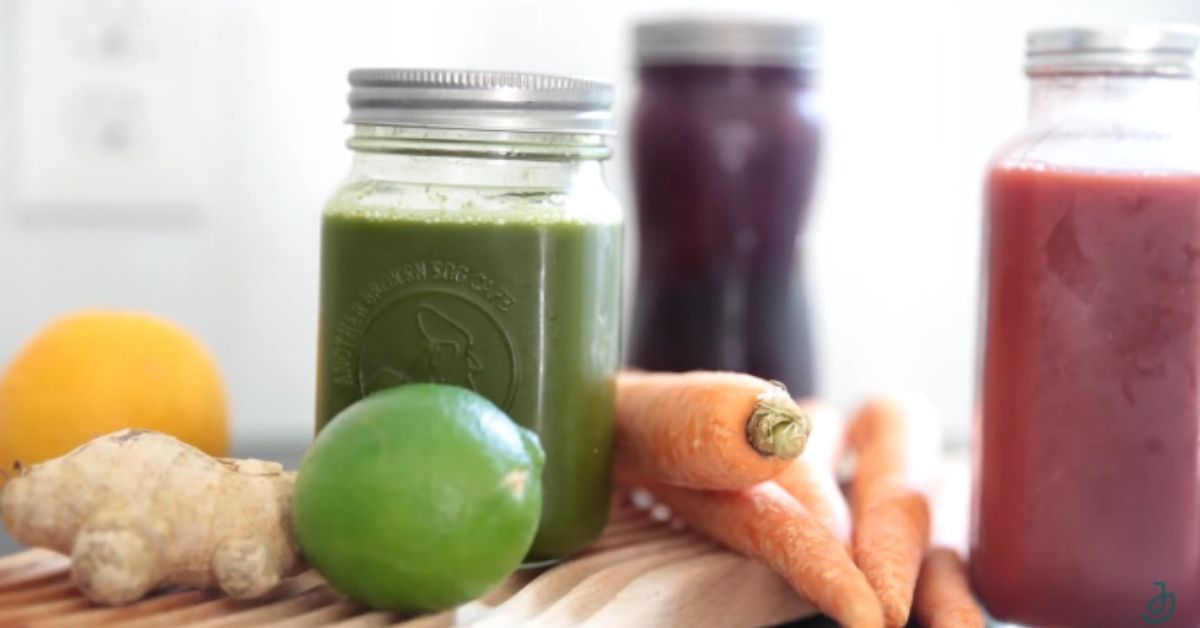Imagine starting your day with a burst of anti-inflammatory goodness that not only revitalizes your body but also combats inflammation. Juicing for inflammation is a delightful, nutrient-packed approach that harnesses the power of natural fruits and vegetables to help reduce bodily inflammation and promote overall health. This method has gained popularity as more people seek natural remedies to enhance their wellbeing.
Juicing allows for the extraction of a high concentration of vitamins, minerals, and antioxidants found in produce, directly aiding in the fight against inflammation. Whether it’s the bright zest of ginger or the robust freshness of kale, these ingredients are key players in inflammation reduction. Dive into the world of juicing and discover how these vibrant concoctions can make a positive impact on your health and vitality.
Ingredients
To maximize the anti-inflammatory benefits of your juice, select ingredients that are rich in antioxidants and flavonoids. Here’s a blueprint to create a nutrient-packed drink that not only calulates inflammation but also invigorates your taste buds.
Anti-Inflammatory Ingredients
- Turmeric Root: 2-inch piece, peeled – famed for its curcumin content, turmeric is a powerhouse in fighting inflammation.
- Ginger Root: 2-inch piece, peeled – adds a spicy kick and excellent anti-inflammatory properties.
- Pineapple: 1 cup, cubed – packed with bromelain, which helps in reducing inflammation.
- Carrots: 3 large, peeled and ends trimmed – rich in beta-carotene and antioxidants.
- Celery: 2 large stalks – provides a calming effect and aids in inflammation reduction.
- Green Apple: 1 medium, cored and quartered – adds a hint of sweetness and a wealth of anti-inflammatory benefits.
- Lemon: 1 whole, peeled – vitamin C is a strong antioxidant, crucial for dispelling inflammation.
Additional Flavor Boosters
To enhance the flavor and add a layer of complexity to your juice, consider incorporating:
- Fresh Mint Leaves: A handful – besides its refreshing flavor, mint has anti-inflammatory properties.
- Cucumbers: 1 medium, peeled – adds a hydrating element and a mild taste, making your juice smoother.
- Beetroot: 1 small, peeled and quartered – introduces sweetness and helps lower blood pressure along with anti-inflammatory effects.
- Flaxseeds: 1 tablespoon, ground – includes Omega-3 fatty acids, which are crucial for reducing inflammation.
Blend these ingredients according to the juicing instructions provided in the next section to ensure the best texture and extraction of nutrients.
Equipment Needed
To transform the vibrant ingredients listed into a potent, anti-inflammatory juice, you need the right tools. Here’s what you’ll require to ensure you extract the maximum nutritional value and achieve the finest texture in your juices:
Juicer
Opt for a masticating juicer if possible, as it helps in preserving the nutrients and enzymes of fruits and vegetables by operating at a lower speed, thereby reducing heat and oxidation.
Sharp Knife
A sharp knife is essential for efficiently prepping your ingredients. It allows precise cutting to ensure the ingredients can be easily processed by the juicer.
Cutting Board
Choose a sturdy, easy-to-clean cutting board. This will be your primary surface for slicing fruits and vegetables before juicing.
Measuring Cups and Spoons
Accurate measurements are crucial for maintaining the correct ratios in your juice recipes to optimize flavor and health benefits.
Citrus Press (Optional)
If your recipe includes lemons or limes, a citrus press can help you extract maximum juice with minimal effort.
Fine Mesh Strainer (Optional)
To achieve a smoother juice, consider straining the juice through a fine mesh strainer to remove any pulp or excess fibers.
Storage Containers
If you plan to make juice in batches, you’ll need airtight containers to store it in the refrigerator. Glass containers are preferred as they do not absorb flavors and are easy to clean.
Gather these tools before you start juicing to streamline your process. Proper equipment will make juicing easier, faster, and more effective, allowing you to enjoy your anti-inflammatory drink with minimal hassle.
Preparation
Prepare your ingredients and equipment to create nutrient-rich, anti-inflammatory juices. Follow these detailed steps to ensure you extract the healthiest and most flavorful juices possible.
Washing and Chopping
- Begin by thoroughly washing all fresh fruits and vegetables under cold water to remove any pesticides, dirt, or bacteria. It’s crucial to cleanse leafy greens carefully as they tend to harbor more dirt and residues.
- Use the sharp knife and cutting board to chop your ingredients. Size them uniformly to ensure they process easily and consistently in your juicer.
- For items like ginger or turmeric, peel the skin lightly, then chop into smaller pieces about the size of a dime to enhance the extraction process.
- Berries and small fruits can be juiced whole, but larger fruits like apples and oranges should be cut into wedges, removing any seeds or pits.
- Always keep your juicer and tools clean and assembled before starting. This maintains hygiene and efficiency throughout the juicing process.
- Pre-soften harder ingredients, like carrots or beets, by soaking them in warm water for a few minutes before juicing. This small step can significantly ease the juicing process.
- Alternate between soft and hard ingredients when feeding them into the juicer. This technique helps in pushing through the softer items effectively and maximizes juice yield.
- If you choose to add leafy greens, bundle them tightly and sandwich them between pieces of harder fruits or vegetables to aid their passage through the juicer without clogging.
- Stir your juicer contents occasionally to ensure a consistent flavor and nutrient profile in your juice.
Juicing Instructions
Now that you’ve prepped your anti-inflammatory ingredients and set up your juicing equipment, let’s dive into the juicing instructions to craft your health-boosting drink.
Combining Ingredients
Start by placing soft ingredients like pre-washed spinach or kale into the juicer first. This creates a moist base for other elements to pass through more easily. Follow these with harder ingredients, such as chopped ginger root, turmeric, and apples, to push through and extract maximum juice. If you’re using citrus fruits like oranges or lemons, it’s efficient to peel them and cut into appropriate sizes that fit your juicer’s feed tube. Alternate between the different textures to ensure smooth operation and prevent jamming.
Juicing Process
Begin the juicing process by slowly feeding the chopped ingredients into the juicer’s chute. Doing this gradually promotes better extraction and prevents overloading the machine. Use a tamper if available to safely push down the ingredients. Once all the ingredients are juiced, stir the mixture in the juicer’s container to blend the flavors and distribute the nutrients evenly. For the best taste and nutritional benefits, serve the juice immediately or store it in an airtached, cold container to maintain freshness. Remember to clean your juicer immediately after use to avoid residue build-up, ensuring it remains in optimal condition for your next juicing session.
Serving Suggestions
After mastering the art of juicing with your anti-inflammatory ingredients, knowing how to serve these nutrient-rich juices enhances the experience and benefits. Here are some optimal ways to enjoy your freshly made juices.
Optimal Temperature to Serve
Serve your juice chilled to elevate the freshness and appeal. You can refrigerate your juice for about 30 minutes before serving or use a few ice cubes to cool it quickly. Avoid prolonged chilling as it might reduce the potency of some enzymes and antioxidants.
Pairing With Meals
Integrate your anti-inflammatory juice into your daily meals. A glass of juice can be particularly refreshing and beneficial when consumed in the morning with breakfast or used as an afternoon pick-me-up instead of coffee. The juices pair well with light meals such as salads or whole grains, enhancing nutrient absorption and digestion.
Glassware and Presentation
Choose clear glassware to showcase the vibrant color of your juice, which can range from deep greens to bright oranges, depending on your chosen ingredients. A well-presented juice can enhance the overall drinking experience. Garnish with a slice of lemon, a sprig of mint, or a celery stalk to add a touch of elegance.
Incremental Juicing for Guests
When serving guests, consider juicing in small batches to maintain flavor and nutrient integrity. Freshly juiced drinks provide a sensory experience, from the sound of the juicer to the aroma of fresh fruits and vegetables, which can be part of the entertainment.
Storing for Later Use
If you must store your juice, do so in a tightly sealed container and consume it within 24 hours. Fill the container to the top to minimize air exposure, which can oxidize and degrade the nutrients. Always store in the refrigerator to keep the juice as fresh as possible.
By following these serving suggestions, you ensure that every glass of your homemade anti-inflammatory juice is as beneficial as it is delightful, keeping true to your healthy lifestyle goals.
Storage Tips
When you’ve taken the time to select, prepare, and juice your anti-inflammatory ingredients, proper storage is crucial to ensure you preserve the freshness and potency of your juice. Here’s how to keep your nutrients intact and your juice tasting fresh.
Choose the Right Containers
Always use airtight, non-reactive containers for storing your juice. Glass jars with tight-fitting lids are ideal as they do not impart any flavors into the juice and prevent oxidation. Make sure to fill your containers to the brim to minimize air space, which can accelerate nutrient degradation.
Refrigerate Immediately
As soon as you’ve made your juice, transfer it to the fridge. Keeping your juice cold slows down the oxidation process, helping preserve its vibrant color, delicate flavors, and nutritional value. Aim to keep the refrigerator temperature at about 34°F to 38°F.
Limit Light Exposure
Light can also degrade the nutrients in your juice, particularly light-sensitive vitamins such as vitamin C and some B vitamins. Store your juice in a dark part of your refrigerator, such as the vegetable drawer, or use an opaque container to shield it from light.
Consume Quickly
For the best taste and nutrient retention, consume your juice within 24 hours. While some juices, depending on their pH and ingredient composition, can be stored for up to 72 hours, fresher is always better. If you notice any separation or changes in taste, consume the juice immediately to ensure you’re getting the maximum health benefits.
Freezing for Longevity
If you need to store your juice for extended periods, freezing is a viable option. Pour the juice into ice cube trays or small, freezer-safe containers, leaving a little space at the top as the juice will expand when frozen. This method is perfect for extending the life of your juice without significant loss of nutritional value; simply thaw in the refrigerator overnight when you’re ready to drink.
By following these storage tips, you ensure your anti-inflammatory juices remain fresh and nutritious, ready to deliver health benefits whenever you need them.
Conclusion
Embracing the art of juicing for inflammation can transform your approach to health and wellness. Equipped with the right ingredients and techniques you’re now ready to create powerful anti-inflammatory juices that not only taste great but also offer significant health benefits. Remember the importance of freshness and proper storage to ensure you’re getting the most out of your nutritious concoctions. Dive into this wholesome practice and you might just find your body thanking you for all the natural goodness you’re providing. Here’s to a healthier happier you!
Related Posts:
- Unlocking the Amazing Health Benefits of Juicing Pears: Tips & Recipes
- Top 10 Benefits of Juicing: Boost Health with Every Sip
- Beginner’s Guide: How to Incorporate Juicing Into Your Diet for Health
- Explore the Advantages of Cold Pressed Juice: Health and Eco-Benefits
- Juicing for IBS Relief: Best Practices and Effective Juices
- Ultimate Guide to Juicing for Inflammation: Tips, Ingredients & Techniques
- Top Immune System Boost Juice Recipes for Vibrant Health
- Boost Your Eye Health: Ultimate Guide to Juicing for Vision
- Top Juicing Recipes for Heart Health: Boost Your Cardio with Nature’s Best
- Does Orange Juice Cleanse Your System? Debunking Detox Myths


